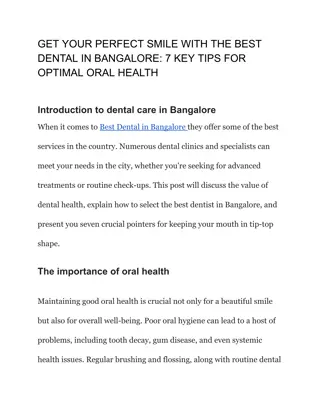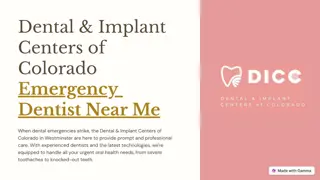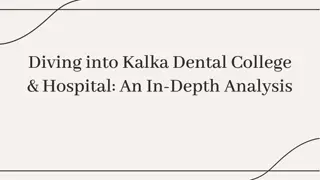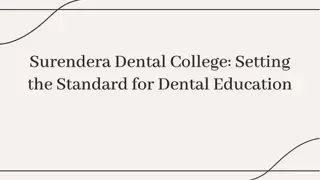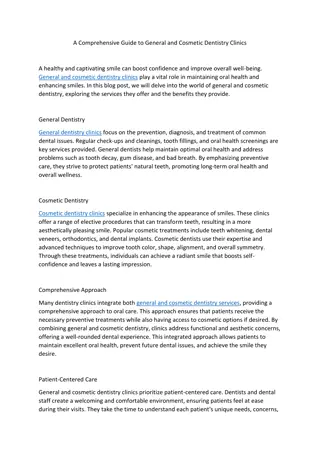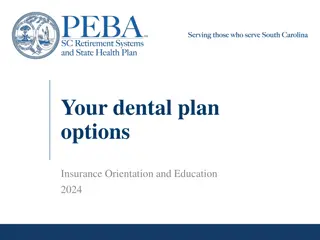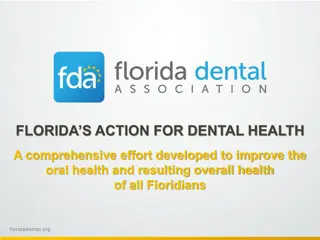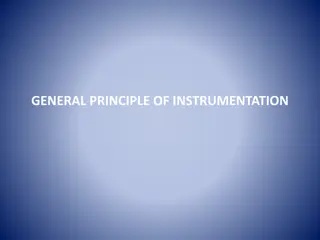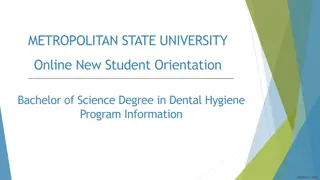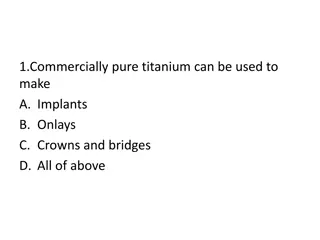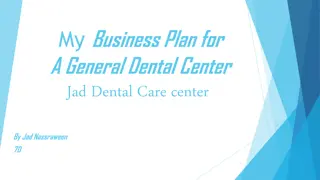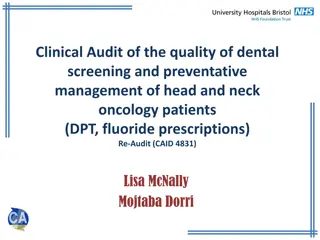Dental Treatment Planning: Strategies and Considerations
Dental treatment planning involves formulating a strategy to address various dental problems based on diagnostic findings, solutions, and patient preferences. This process includes identifying issues, offering solutions, considering medical status, and setting treatment goals to ensure effective care and patient satisfaction. Collaboration between dentists and patients is crucial for successful treatment outcomes.
Download Presentation

Please find below an Image/Link to download the presentation.
The content on the website is provided AS IS for your information and personal use only. It may not be sold, licensed, or shared on other websites without obtaining consent from the author. Download presentation by click this link. If you encounter any issues during the download, it is possible that the publisher has removed the file from their server.
E N D
Presentation Transcript
Treatment planning Oral diagnosis,Oral Medicine & Treatment Planning GARY C. COLEMAN PROF. M.HAMAM FACULTY.KSU.EDU.SA/PROF.HAMAM
Definition It is the formulation of a strategy to solve as many of the patient s dental problem as possible . The dentist must consider the following :- 1- Diagnostic finding indicative of dental problems . 2- Possible solution to these problems. 3- The preference of the patient while designing the best possible treatment approach.
Listing the identified problems and their possible solutions. The chief complaint Such as ( pain , acute infection , bleeding and traumatic injury ) Palliative care , to control the symptoms of a diagnosed problem . ( pain killer , medication , antibiotic ) 1-Curative treatment : a- Definitive treatment ( extraction , pulp exacerbation ) b- less urgent chief complaint ) ( loss restorations , pulpitis ,carious lesion ) Zinc oxide & eugenol cements c- Cleaning or replacing of missing teeth, can be delayed until a definitive treatment plan is formulated
2-Medical status Compromised cardiovascular function , asthma , epilepsy , bleeding disorders , pregnancy , diabetes , Medical consultation Uncontrolled patient , ( past medical history ), Undiagnosed medical conditions Laboratory investigation to confirm the dentist suspicion ( undiagnosed diabetes ) 3- Dental disease and conditions Periodontitis , ( dental prophylaxis , plaque control , periodontal surgery ) Degenerative dental lesions Carious teeth Pulpitis Complications of eruption ( orthodontic treatment - extraction ) Missing teeth ( fixed or removable prosthesis )
Determination of dental treatment goals Some times , technically superior treatment plan fails because :- The patients will refuse the treatment if the expense is excessive and the procedures ignore the patient s preference An alternative plan formulated with primary considerations for cost limitation ( lower priority ) The priority considerations that are most appropriate for patient ( dental treatment goals ) . The dentist s perspective & the patient perspective determine these goals during the case presentation .
The patients perspective 1- Chief complaint . 2- The patient s chief complaint should become the dentist s chief treatment priority . 3- The patient s dental expectations. Financial limitations . Some patients accept dental treatment plan without asking the cost & other patients prefer to keep dental expenses to a minimum . There are times when even minimal care is beyond the patient's means.
The patients dental altitudes The patient s confidence ( requires time ) . The dentist s knowledge ( positive experiences ) . Early stage ( dentist patient relationship ) become confrontational & counterproductive this situation may require delaying treatment planning until a stronger dentist patient relationship emerges . Alterations in treatment plans to accommodate ( fear of pain , gagging emotional responses) ( premedication sedation Nitrous oxide appointment times & numbers )
The Dentist s Perspective A- the patient s dental condition B- prognosis C- potential complications of dental treatment * C. denture partial denture gagging sensation. * Infected endocarditits d- Referral for specialty treatment e- Financial considerations ( third parties such as dental insurance ) Specific Dental Treatment Goals ( emergency , comprehensive dental treatment ) a- Emergency dental treatment extraction , palliative pulpotomy , periodontal infection control , less urgent dental problems ( ill-fitting removable partial denture ) b- limited treatment plans in certain circumstances ( a patient might request that an anterior tooth be restored before a special event such as a family gathering )
Dental disease control treatment This treatment goal reflects agreement between the dentist & patient that all identified problems cannot be solved because of limitations Such as money or available time . Tentative dental treatment . The goal of the tentative treatment plan is to specify initial disease control procedures for cases in which the initial treatment outcome cannot be confidently predicted . * Tentative treatment are useful in cases of advanced periodontitis and in cases of extensive carious lesions and missing teeth ( potential of abutment teeth to function ). Comprehensive dental plan It is goal is the decision by the patient & dentist to plan the procedures necessary to solve all patient s dental problems
Case presentation Presentation of diagnostic findings Presentation of planned treatment Preliminary treatment plan Alternative treatment plan Consequences of treatment Questions and clarification Reassessment of treatment goals
Setting priorities The optimal treatment sequence . Rearrange all the treatment procedures necessary to solve the patient s Problem in the most logical treatment sequence . Pretreatment phase Physician communication , medical & dental consultations . lab. Investigation , radiograph , study models ,( before active treatment ) Phase 1 Control pain & acute infection . Extraction of painful teeth . Incision and drainage of abscess. Management of traumatic injuries. Pulpectomy Excavation of deep carious lesions Sedative temporary restoration . Pulp capping procedures . Biopsy of any lesion
Phase 11 :- Treatment to control active disease ( preparatory phase ) Scaling ,root planning and oral hygiene instruction . Decayed removal of extensive carious lesions Extraction of destroyable teeth . Endodontic procedures . Surgical periodontal therapy . Phase 111 :- Restoration of esthetics and function Operative dental restoration Orthodontic treatment . Prosthodontic treatment
Phase IV : Re-evaluation of treatment . ( to confirm that ) Treatment in progress No new lesions have developed Appliance Follow up of home care Phase V : - Recall The early identification of new lesions and oral conditions Re-evaluate past dental treatment . Treatment options for non-dental oral problems It depends on systemic conditions








